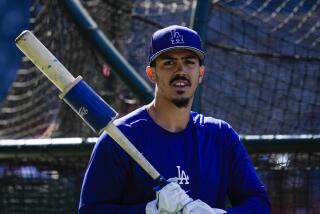Positioned for Success
- Share via
Ryne Sandberg could have played just about anywhere on a baseball diamond. He wound up in the right spot and is going into the Hall of Fame on Sunday because he played second base, not third or the outfield.
Sandberg played mostly shortstop in the minor leagues. Philadelphia traded him to the Chicago Cubs in part because he was stuck behind veterans such as Mike Schmidt and Manny Trillo. He played 133 games at third base in 1982, his first season with the Cubs, and almost was shifted to center field instead of across the infield after that season. But even though he was versatile, he never was anything except a second baseman once Manager Lee Elia put him there.
At some point before Sand- berg’s induction speech, it probably will be said he revolutionized his position and blazed the trail for offensive-minded second basemen such as Jeff Kent and Alfonso Soriano.
There might be a kernel of truth in that, especially because Sandberg’s hitting was burned into the memory of the generation of baseball followers who overdosed on the Cubs and Atlanta Braves on cable superstations before there was a “Baseball Tonight,” but the mold was made long before Sandberg came along.
Sandberg was more a link in the chain of good-hitting second basemen -- from Napoleon Lajoie to Eddie Collins to Rogers Hornsby to Charlie Gehringer to Jackie Robinson and Joe Morgan -- than he was a pioneer.
Sandberg won a home run crown playing second base, but so did Lajoie, in 1901, and Hornsby, in 1922 and ’25. Sandberg was second in the league in slugging; Bobby Doerr led his league in 1944. Sandberg had a pair of 100-RBI seasons; Gehringer had seven.
Measuring offensive impact in any generation is difficult. Comparing eras can be an exercise in futility, but here is a try at both.
On-base average plus slugging percentage (OPS) balances the ebb and flow of offensive statistics by comparing players to their league averages, with an individual plus-minus total. Divide the players’ career plus-minus by years played, which baseball-reference.com has done, and you get an average single-season plus-minus for each player.
Here’s how the Hall of Fame second basemen rank:
1. Hornsby, +175; 2. Lajoie, +150; 3. Collins, +141; 4. Morgan, +132; 4(t). Robinson, +132; 6. Rod Carew, +131; 7. Gehringer, +124; 8. Tony Lazzeri, +121; 9. Doerr, +115; 10. Sandberg, +114; 11. Billy Herman, +112; 12. Frankie Frisch, +111; 13. Bid McPhee, +106; 13(t). Johnny Evers, +106; 15. Nellie Fox, +94; 16. Red Schoendienst, +93; 17. Bill Mazeroski, +84. (Note: Carew also played first base and was a designated hitter.)
As productive a hitter as Sandberg was for the Cubs, helping his teams win division titles in 1984 and ‘89, he barely makes the list of the 10 best offensive second basemen, and falls further when you include players not yet in the Hall.
That list includes:
Cupid Chiles (who played 1,467 games between 1888 and 1901), +126; Bobby Grich, +125; Kent, +125; Joe Gordon, +120; Larry Doyle, +117; Roberto Alomar, +116; Craig Biggio, +116. (Note: Totals for Kent, Alomar and Biggio are through 2004.)
Perhaps that’s why it took three ballots for Sandberg to be elected.
While Sandberg is remembered for the power he provided at a position that was largely populated by table-setters, he probably would not have gained enough support for the Hall if he had not been a complete player. He won nine Gold Gloves -- four more than Morgan -- and stole 20-plus bases in nine seasons, including 54 in 1985.
“I strived to be the best all-around player that I could be,” Sandberg said. “That’s offense, defense, baserunning, bunting, being able to get the guy over to third base with a man on second and no one out, doing little things, and doing a lot of things correctly.... I was the type of player that if you watched one game, you might not be too excited about. But if you watched 162 games played, then I think you might see something.”
Once he became one, Sandberg was never anything except a second baseman. He played in one game at short in 1985 and one as a designated hitter in ‘97, his final season.
That’s the example he set for guys such as Soriano, Kent and Ray Durham. If you can get to enough ground balls and turn enough double plays, you will get more recognition playing second base than the positions where the big guys roam.
*
(BEGIN TEXT OF INFOBOX)
Second thoughts
How Ryne Sandberg’s statistics compare with those of other power-hitting Hall of Fame second basemen and those of some current second basemen:
*--* HALL OF FAMERS AB R H 2B HR RBI AVE. Ryne Sandberg 8385 1318 2386 403 282 1061 285 Rogers Hornsby 8173 1579 2930 541 301 1584 358 Joe Morgan 9277 1650 2517 449 268 1133 271 ACTIVE AB R H 2B HR RBI AVE. Jeff Kent * 6960 1098 2018 462 320 1276 290 Craig Biggio * 9590 1666 2741 592 250 1039 286
*--*
* Statistics through Thursday
More to Read
Go beyond the scoreboard
Get the latest on L.A.'s teams in the daily Sports Report newsletter.
You may occasionally receive promotional content from the Los Angeles Times.










